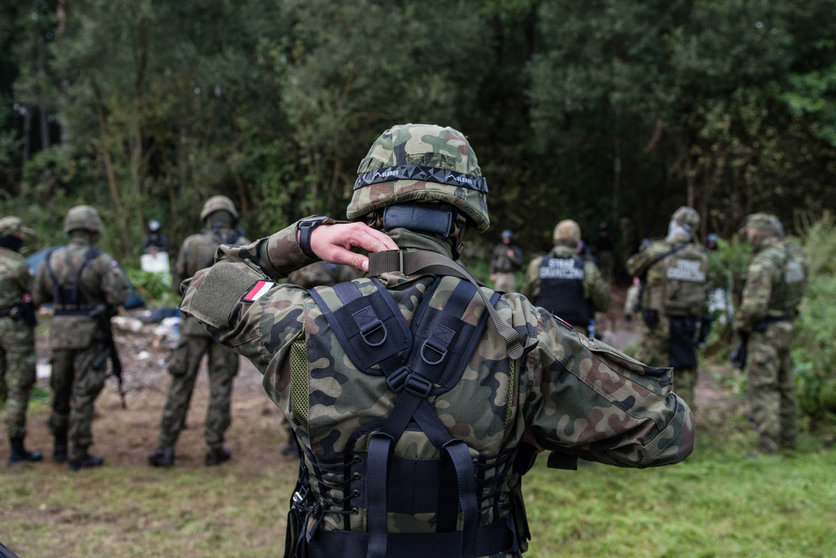As the situation in Afghanistan worsens after the Taliban reconquered the country, EU countries are preparing for a likely increase in the influx of migrants to the bloc.
EU interior ministers are due to discuss the developments in Afghanistan on Tuesday, but some member states have already taken matters into their own hands and announced reinforcements to their physical borders.
Since the massive migration movement from Syria in 2015, fortifications and barb wire have gone up along the borders of some EU countries, mostly to keep out migrants - despite the right to asylum anchored in international law. More than half of the bloc's members have now built physical barriers to secure their territory.
With more people likely to come from Afghanistan, possibly via new routes like Belarus, many have vowed to further reinforce the existing fences and walls. Here's an overview of the European Union's border fortifications.
CENTRAL EUROPE:
- POLAND: Last week, works began for a barrier along the 400-kilometre-long border with Belarus to prevent irregular crossings. The fence is to span 190 kilometres, in addition to 130 kilometres already protected by barbed wire. Some 1,500 soldiers currently help protect the border, with an additional 500 to arrive as reinforcement.
- HUNGARY: A fence topped with extra-sharp razor wire covers the whole border with Serbia. The pet project of right-wing Prime Minister Viktor Orban, which is equipped with drones and thermographic cameras, cost about 1.5 billion euros (1.7 billion dollars) and was built in September 2015. A more low-cost version with barbed wire was used at the western border with Croatia.
- AUSTRIA: There is a fence along 4.4 kilometres of the border with Slovenia, which was built in 2015. The fence, which has been dismantled in places to allow hikers to pass, cuts through the Schengen zone, in which travel is usually allowed without border checks.
BALKANS AND SOUTH-EAST-EUROPE:
- SLOVENIA: Almost half of the 500-kilometres-long border with Croatia is covered by a fence topped with barbed wire. Croatia is a fellow EU country but not a member of the Schengen zone, and it sits on the Balkan route to Central Europe.
- GREECE: The government is trying to prevent migrants from crossing the EU's external border with Turkey along the Evros river (also called Mariza) by building 27 kilometres of fences at shallow areas, in addition to 11 kilometres of already existing barriers. The fences are surveilled by thermographic cameras, drones and an air ship of the EU border agency Frontex. Barbed wire was also laid out at the border triangle with Bulgaria and Turkey to prevent people smugglers from operating, and there is a 34-kilometres-long fence along the North Macedonian border.
- CYPRUS: The southern Cypriot government has built a fence with barbed wire cutting through the divided capital Nicosia. It is meant to keep migrants coming from Turkey to the Turkish-Cypriot north of the island and then crossing into the south, which is part of the European Union.
- BULGARIA: The whole of the 259-kilometres-long border with Turkey has been fortified with barbed wire fencing and thermographic cameras since 2017. Due to the crisis in Afghanistan, the government has ordered the army to help out with border controls.
BALTICS AND SCANDINAVIA:
- LITHUANIA: Vilnius has announced it is building a fence along its 508-kilometres-long border with Belarus to prevent illegal crossings, after Minsk let an increasing number of people pass into the bloc as retaliation against EU sanctions. The fence is to be completed in 2022. Barriers already exist along the border with the Russian exclave Kaliningrad, which were built amid rising tensions with Russia in 2017.
- LATVIA: Riga is also under pressure to protect its borders against the influx of migrants via Belarus, deploying barbed wire along 37 kilometres of the two countries' borders. Latvia is also building fences along its Russian border amid rising tensions with Moscow, though they are not completed yet.
- ESTONIA: Tallin is building 115 kilometres of fence along its Russian border, with works to be completed by 2026, according to Interior Minister Kristian Jaani.
- NORWAY: There are fences along 200 metres of the border with Russia, after numerous migrants crossed into Norway by bike in 2015.
WEST AND SOUTH-WEST-EUROPE:
- FRANCE: The British government has invested millions in the construction of walls and fences in the port area of the French city of Calais, to prevent migrants from travelling from the EU to Britain. London and Paris recently agreed to step up border controls further.
- SPAIN: The Spanish government in the 1990s set up fences around the northern African exclaves Ceuta and Melilla, which separate them from the territory of Morocco. The barriers - which are 8 and 12 kilometres long respectively - have progressively been upgraded. They are now 10 metres high, with two parallel fences separated by a web of steel cables watched by thermographic cameras to make crossing the fence even more difficult.










